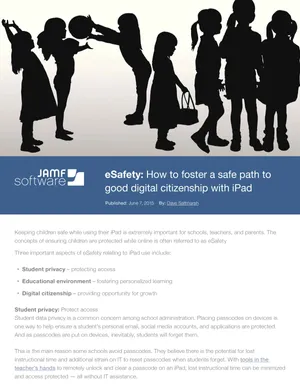Keeping children safe while using their iPad is extremely important for schools, teachers, and parents. The concepts of ensuring children are protected while online is often referred to as eSafety.
Three important aspects of eSafety relating to iPad use include:
- Student privacy – protecting access
- Educational environment – fostering personalized learning
- Digital citizenship – providing opportunity for growth
Student privacy: Protect access
Student data privacy is a common concern among school administration. Placing passcodes on devices is one way to help ensure a student’s personal email, social media accounts, and applications are protected. And as passcodes are put on devices, inevitably, students will forget them.
This is the main reason some schools avoid passcodes. They believe there is the potential for lost instructional time and additional strain on IT to reset passcodes when students forget. With tools in the teacher’s hands to remotely unlock and clear a passcode on an iPad, lost instructional time can be minimized and access protected — all without IT assistance.
Educational environment: Personalize learning
To get the most out of classroom time, teachers need to personalize learning and foster students’ engagement. The best way to do this is to allow them the freedom to work on projects that they enjoy, while still driving learning forward.
Teaching in this environment can be a change and an adjustment for many teachers. One resource to support this change is Casper Focus. As students are actively engaged, teachers can draw their attention back as necessary by using a new Casper Focus feature that allows them to send a customized message to each student’s iPad. This temporarily pauses what the student is working on and allows the teacher to provide instruction.
Digital citizenship: Opportunity for growth
To offer a sense of personal ownership and responsibility, IT staffs can provide access to certain apps and webpages to individuals or groups based on grade, ability, or maturity level. Students can earn their way into accessing more content on their device. Not all devices will be the same and access can be based off of digital citizenship level. This promotes higher levels of digital citizenship so that students can do more things on their iPad (like the things that their friends may have access to.)
So when it comes to eSafety in schools there is a balance. And the best way to strike the right balance is to ensure student privacy and maintain an educational environment that’s flexible enough to promote good digital citizenship.

